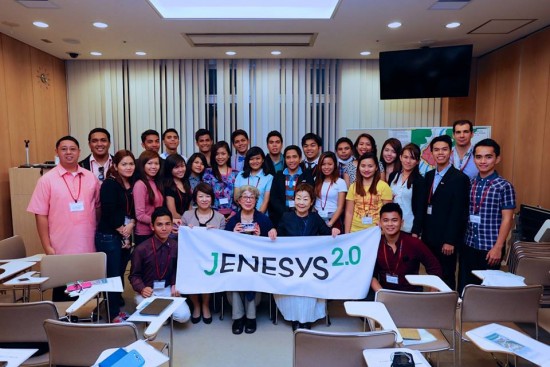
Three atomic bomb survivors (center) pose with the Philippine delegation after sharing their stories of hope. Photo by Komori Hideki.
The National Youth Commission (NYC) chose five students from the Ateneo de Davao University (AdDU) as participants in the Japan East Asia Network of Exchange for Students and Youth (JENESYS) 2.0: Mindanao Peace and Community Development Course held last September 24 to October 2 in Japan.
AdDU students Jeson Paul Cabug-os, Marielle Mae Paler, Rica Glee Pascual, Lyka Picardal, and Fritzie Lynne Sumando passed the screening process and represented the Philippines as part of the delegation that was composed of 23 students and two supervisors.
Japan’s Ministry of Foreign Affairs (MOFA) hosted the program through the Japan Overseas Cooperative Association (JOCA). The program’s objective is to impart greater understanding and appreciation of each participating country’s historical and cultural background, lifestyle, and way of thinking. It is aimed to revitalize the Japanese economy by promoting international understanding, and the introduction of the ‘Cool Japan’ concept.
The course theme focused on the introduction of Japan’s advanced methods for social community development towards achieving peace. Aside from Tokyo, the Philippine delegation stayed in Hiroshima for a 5-day exposure, where they were able to gain greater understanding of the concept of peace following the tragic 1945 Atomic Bombing that hit Hiroshima.
“I realized that when there is understanding, we are able to respect each other’s differences, and with the respect comes peace,” Sumando stated.
The participants had site visits at the historic Hiroshima Peace Memorial Museum, Atomic Bomb Dome, and Itsukushima Shrine. They also engaged in cultural exchanges with Japanese students and a home stay with a Japanese family.
Visits at the National Museum of Emerging Science and Innovation, Odaiba, Akihabara, Mazda Museum, and Shukkein Gardens further showcased the Japanese culture of fashion, technology, food, and games.
“It is possible to find unity in diversity in a mission to achieve international peace and stability if we all work hard together,” Sumando concluded.